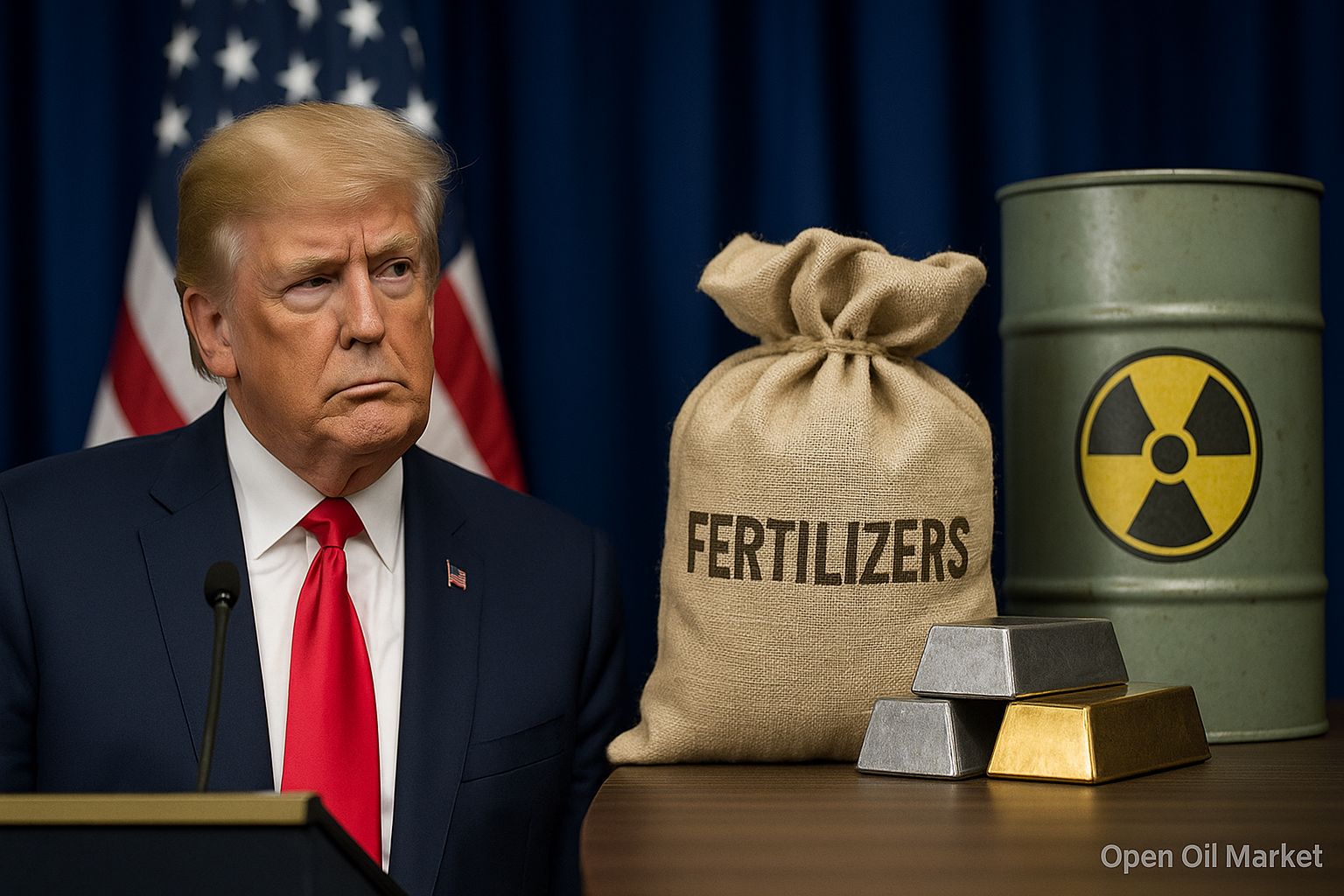
What the U.S. Imports from Russia — Uranium, Fertilizers, and Palladium
Despite the stringent sanctions imposed by Washington against Moscow following the onset of the war in Ukraine, the United States continues to import a range of strategically important goods from Russia. In 2024, the volume of imports from Russia to the U.S. was approximately $3 billion — nearly a 90% decrease compared to 2021 (the last year before the conflict) — but still includes fertilizers, precious metals, and nuclear fuel. This fact has gained attention amidst Washington's recent criticism of India for purchasing Russian oil: the Indian Ministry of External Affairs pointed out that the U.S. still imports uranium, palladium, and fertilizers from Russia.
Trade Dynamics: A Sharp Decline After 2021
In 2021, prior to the conflict, the United States imported goods from Russia worth nearly $30 billion. In 2022, this figure plummeted to around $14 billion, in 2023 to $4.6 billion, and by 2024 it shrank to $3 billion. Thus, over three years, the volume of imports collapsed by nearly 90%. The main reason was the cessation of energy cooperation: while in 2021, Russian oil accounted for the majority of imports (over $17 billion), after the embargo on oil, gas, and coal purchases was introduced in 2022, these supplies almost ceased. By 2024, the import of several other goods, such as fish and seafood, nickel, and lead, also completely stopped.
Main Import Items in 2024
Despite the overall decline, the U.S. continued to source a number of goods from Russia. In 2024, approximately 90% of American imports from the Russian Federation were accounted for by a few categories:
- Fertilizers (urea, potash, etc.) — $1.3 billion.
- Precious metals (palladium, platinum, etc.) — $878 million.
- Inorganic chemicals, including radioactive materials — $695.7 million.
- Uranium hexafluoride for nuclear fuel — $624 million.
- Aircraft parts and components — $75 million.
- Wood and wood products — $89.4 million.
- Machinery and reactors — $80.8 million.
- Animal feed, food processing waste — $39.9 million.
- Edible vegetables, fruits, and foodstuffs (various categories) — totaling over $15 million.
- Shoes, textiles, toys, and watches — totaling over $10 million.
- Miscellaneous imports — from raw hides to printed books and even live animals.
Fertilizers: The Largest Import Item from Russia
Fertilizers have become the largest import item for the U.S. from Russia. In 2024, American imports of Russian fertilizers amounted to approximately $1.3 billion, constituting around 43% of total imports from Russia. This volume is only slightly (around 8%) lower than the level in 2021, meaning fertilizer supplies have decreased marginally compared to the last pre-war year. Russia is one of the leading global producers of mineral fertilizers (particularly nitrogen-based, such as urea, and potash, like potassium chloride), and U.S. agriculture still partially depends on these imports. Furthermore, in early 2025, purchases of fertilizers from Russia even increased. From January to May 2025, the U.S. imported Russian fertilizers worth $806 million, which is 21% more than during the same period in 2024 and 60% more than in the first five months of 2021. Thus, even amidst sanctions, the demand for agrochemical products leads to the continuation and sometimes growth of fertilizer supplies.
Palladium and Other Precious Metals
The second largest import category was precious metals, primarily palladium. In 2024, $878 million worth of metals were imported from Russia (about 30% of the total import volume). Palladium and platinum are mainly used in the automotive industry: they are utilized in catalytic converters for reducing emissions in internal combustion and hybrid vehicles. Russia has historically been one of the largest suppliers of palladium to the global market, so even after sanctions were imposed, American companies continued to source it. However, the volume of precious metal imports has significantly decreased relative to pre-war levels — approximately 45% lower compared to 2021. This is due to the search for alternative sources (such as increased purchases from other producers like South Africa) and technological trends: as the transition to electric vehicles progresses, the need for palladium is likely to decrease, as catalytic converters are not required in electric vehicles.
Nuclear Fuel and Uranium Supplies
Another critically important category remains nuclear fuel. In 2024, the U.S. imported enriched uranium (in the form of uranium hexafluoride for nuclear power plants) from Russia worth $624 million — almost the same amount as before the war (a decrease of only 3% compared to 2021). This indicates the continued dependence of American nuclear energy on Russian raw materials. The Russian state corporation Rosatom and its subsidiaries traditionally met a significant portion of the U.S. needs for enriched uranium. Although Washington announced in 2024 its intention to completely halt imports of Russian nuclear fuel, delays have practically been implemented: American companies are permitted to continue purchases as needed until 2028. Partially, this explains the recent surge in supplies: in the first five months of 2025, uranium imports from Russia increased by 28% year-on-year, reaching $596 million (compared to around $241 million during the same period in 2021). It is evident that market participants are trying to stockpile material in anticipation of stricter restrictions.
Other Supplies: Wood, Machinery, and Consumer Goods
Besides the aforementioned strategic categories, small shipments of other goods from Russia continue. In 2024, wood and wood products were imported for about $89 million. Separate batches of machinery and equipment (including nuclear reactors) were brought in worth around $80 million, as well as livestock feed additives and food waste amounting to approximately $40 million. There were also food product imports, including edible vegetables and fruits, with a total value exceeding $15 million. Small batches of some consumer goods continued to arrive: shoes, textiles, toys, and watches (totaling just over $10 million). The statistics even included items like raw hides, printed books, or live animals, but their volumes were insignificant. Collectively, all other categories comprise only a small portion of the overall import structure.
Political Context and Future Prospects
The persistence of even limited imports from Russia carries a political dimension. India, justifying its purchases of Russian oil, pointed to the ongoing supplies from the U.S. — from fertilizers to uranium — as an example of double standards. In the United States itself, some political factions are calling for a tougher stance. For instance, former President Donald Trump proposed imposing 100% tariffs on all countries continuing trade with Russia if Moscow does not cease hostilities in Ukraine within 50 days. However, it is currently challenging for America to completely abandon the remaining Russian goods. The total volume of $3 billion accounts for less than 0.1% of U.S. imports — a figure that is practically at the level of a statistical error. Nonetheless, these supplies meet important needs in individual sectors. Without establishing alternatives — developing domestic production or seeking other suppliers — the cessation of even this small flow could negatively impact the respective sectors of the economy. It is likely that a certain level of trade between the U.S. and Russia will persist in the short term, at least in strategic niches, until comprehensive substitutes for Russian raw materials are found.




